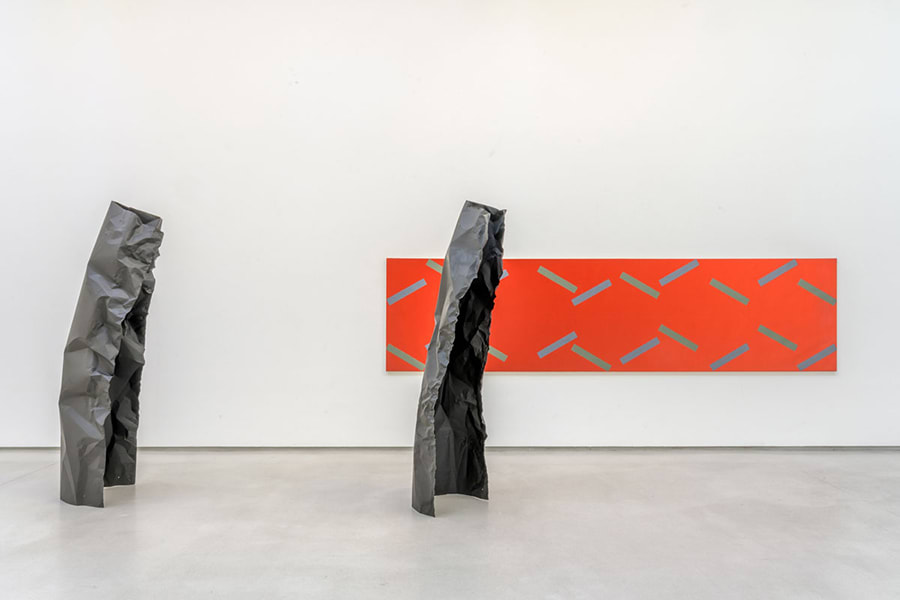
Rosemarie Castoro

A survey show of the late artist’s restlessly inventive work at Galerie Thaddaeus Ropac, Paris
'Wherein Lies the Space', a survey show of work by the late US artist Rosemarie Castoro, literally sets a high bar from the outset. Black Flasher A and Black Flasher B (both 1979), installed near the entrance of the ground-floor gallery, are two towering sculptures of rolled steel that, as their titles suggest, allude to a pair of dirty old men opening their coats to expose themselves. The effect is not obscene, however, since their gestures are implied rather than explicit. What shines through is Castoro’s lightness of touch and razor-sharp wit; it’s hard to shake the sensation that the artist – who died at the age of 75 in 2015 – is there, laughing alongside us.
In the basement gallery, Beaver’s Trap (1977) – comprised of 42 wooden stakes of varying heights arranged in a circle on a raised plinth – is an interplay between vulnerability, female sexuality and hunting. In the ground-floor gallery, Armpit Hair (1972) – a wallmounted sculpture that stretches from the wall to the centre of the room – up close, looks more like a section of cast ploughed earth than its titular namesake, another illustration of Castoro’s engaging sense of humour.
Moving up to the first floor, however, there is a marked shift in tone and energy – not least because the space itself is constricted and dark. On a wall jutting into the main gallery hangs a prime example of Castoro’s painterly prowess. Lyrical and imposing, Orange China Marker (1967) is composed of subtle brushwork and marker pen, pencil and graphite diagonal lines, that pay homage to the seductive, burnt-orange hue in which it is rendered. The startling impact of this painting, however, comes at the expense of works around it, such as the off-white painting, Inventory Series White and Brown (1968) and Grey, Prismacolor Pencil (1967), which are smaller in stature, more sober in delivery and, as a result, somewhat overpowered. Similarly, her concrete poetry series ‘A Day in the Life of a Conscientious Objector’ (1968) – an index of daily tasks and observations from Castoro’s studio, displayed in a narrow passageway – left me feeling more claustrophobic than intrigued.
The second floor of the gallery is dedicated to archival material, including documentary photographs of the ‘Flasher’ series installed at 780 Third Avenue in New York, in 1984 – the high-end Manhattan location lending the work a further layer of social satire. Also on view in this section is a photograph of Castoro choreographing and performing with Frank Calderoni at the Pratt Institute in 1963, the year the artist graduated in visual design and choreography. This formative training provides an insight into the use of space and pattern in Castoro’s works, particularly in early paintings such as Red Blue Purple Green Gold (1965), in which thin rectangles of colour float on top of a gold background; and the performative aspects in sculptural work such as Land of Lashes (1976), which comprises eight steel and fibreglass sculptures resting on a plinth that resemble crawling eyelashes.
While the installation may have its shortcomings, the show succeeds in its ambition to raise the profile of Castoro’s expansive and endlessly evolving art for a European audience. It makes clear that the artist has, for too long, been pigeonholed as a minimalist or conceptualist – categories that deny her unique voice and her idiosyncratic development.
Rosemarie Castoro, ‘Wherein Lies the Space’ was on view at Galerie Thaddaeus Ropac, Paris, from 21 February until 30 March 2019.

Rosemarie Castoro, 'Wherein Lies the Space', 2019, exhibition view. Courtesy: The Estate of Rosemarie Castoro; photograph: Charles Duprat

Rosemarie Castoro, 'Wherein Lies the Space', 2019, exhibition view. Courtesy: The Estate of Rosemarie Castoro; photograph: Charles Duprat